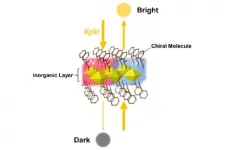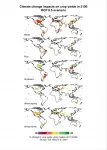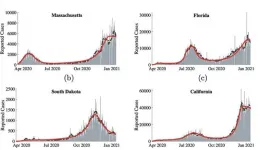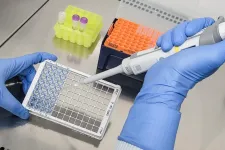What happens in brain cells affected by Alzheimer's disease?
Biochemistry
2021-06-14
(Press-News.org) Moreover, they identified a correlation between the progression of the disease and certain corpuscles in the cell nuclei. They published their report in the journal Acta Neuropathological Communications on 13 April 2021.
Aggregates seem to have a function
Affecting over 50 million people, Alzheimer's disease is the most common form of dementia and primarily occurs in people over the age of 65. The pathology of the disease in the brain is mainly characterised by two factors: beta-amyloid plaques outside the nerve cells and tau proteins. The tau protein stabilises tube-like structures (microtubules) inside cells, which are relevant for the transport of nutrients in nerve cells. Beta-amyloid is a protein present in the body that is formed by the cleavage of the amyloid precursor protein (APP).
APP is embedded in the cell membrane of the nerve cells and protrudes both on the inside and outside. Typically, it is cleaved once near the cell membrane The part inside the nerve cells is unstable and disintegrates. In Alzheimer's patients, two cleavages take place, resulting in the formation of three parts. The new findings now indicate that the part inside the nerve cells is more stable in Alzheimer's patients. It consists of only approximately 50 amino acids and can, under certain conditions, migrate into the cell nucleus together with other proteins such as FE65 and TIP60. This protein complex, also known as nuclear aggregates, has the capacity to manipulate the cell's gene expression. "This suggests that the aggregates have a function in this region," points out lead author David Marks from the Cell Signaling group at RUB. Closer analysis confirmed this evidence, as a protein was found within the nuclear aggregates that is involved in the modification of DNA.
Two more protein candidates in cells
"To understand this mechanism even better, we looked for other proteins that might be part of these aggregates and identified two more candidates involved in the nuclear aggregates, the so-called tumour suppressor proteins P53 and PML," explains David Marks. The study team showed in experiments on living cells that nuclear aggregates formed from the proteins APP-CT50, FE65, TIP60 and PML fuse with each other over time and produce even larger nuclear aggregates.
In addition, they examined brain samples from older deceased persons as well as self-generated neuronal tissue from induced pluripotent stem cells. "These mini-brains, so-called cerebral organoids, reflect the embryonic and developmental phase of a brain fairly accurately," explains Thorsten Müller. The research team found nearly no nuclear aggregates in the comparatively young cerebral organoids, whereas they were present in brain samples from older patients. "This leads us to conclude that the process depends on age," says Müller.
Striking correlation
Furthermore, the researchers showed on these brain samples that APP-CT50 and FE65 can make up part of the so-called PML bodies, which occur naturally in large numbers of cell nuclei. Upon further analysis of hippocampal brain slices from Alzheimer's patients, the authors identified a significant correlation between a reduced number of PML bodies in the nucleus in regions with a high beta-amyloid plaque load. In particular, such regions mean that there is higher expression and processing of APP. This may suggest that the transfer of APP-CT50 and FE65 into the nucleus is part of AD pathology and affects the fusion of PML bodies there.
INFORMATION:
Rubin article on this subject: https://news.rub.de/english/2019-04-30-biochemistry-alzheimers-minibrains
ELSE PRESS RELEASES FROM THIS DATE:
2021-06-14
With Oskar Aszmann and his team at the Department of Plastic, Reconstructive and Aesthetic Surgery, MedUni Vienna has long been regarded as a world leader in bionic limb reconstruction. It was only last year that the world's first fully integrated bionic arm prosthesis was developed at MedUni Vienna. This is ready-to-use and is described as "Plug and Play". Although all bionic aids have so far been used in humans, the technique known as osseointegration (direct skeletal attachment) has now been used for the very first time in a bearded vulture - the creature was given a new foot. A paper on this ground-breaking procedure has been published today (Friday) in the prestigious Journal Scientific Reports.
In large birds such as vultures, the loss of limbs results in the ...
2021-06-14
Researchers at Tohoku University have demonstrated the designability of novel magnets with magic mirror-like characteristics in organic-inorganic hybrid perovskite (OIHP)-type compounds.
OIHP-type compounds, a type of material used to construct solar cells, possess exceptional optical properties and have recently attracted worldwide interest. Researchers are keen to harness their structural diversity.
Although the superior optical properties of OIHPs have been mainly studied for their photoelectric characteristics, several OIHP-type compounds are known to function as magnets that transmit light. Combining the excellent optical ...
2021-06-14
Not only the very concise 11-year cycle, but also all other periodic solar activity fluctuations can be clocked by planetary attractive forces. This is the conclusion drawn by Dr. Frank Stefani and his colleagues from the Institute of Fluid Dynamics at the Helmholtz-Zentrum Dresden-Rossendorf (HZDR) and from the Institute of Continuous Media Mechanics in Perm, Russia. With new model calculations, they are proposing a comprehensive explanation of all important known sun cycles for the first time. They also reveal the longest fluctuations in activity over thousands of years as a chaotic process. ...
2021-06-14
On average the earliest memories that people can recall point back to when they were just two-and-a-half years old, a new study suggests.
The findings, published in peer-reviewed journal Memory, pushes back the previous conclusions of the average age of earliest memories by a whole year.
They are presented in a new 21-year study, which followed on from a review of already-existing data.
"When one's earliest memory occurs, it is a moving target rather than being a single static memory," explains childhood amnesia expert and lead author Dr Carole Peterson, from Memorial University of Newfoundland.
"Thus, what many people provide when asked for their earliest memory is not a boundary or watershed beginning, before which there are no memories. Rather, ...
2021-06-14
Shifts in weather patterns induced by climate change will increase extreme heat and reduce rainfall across major crop growing regions, with impacts on agricultural production. Will this trigger a decline in the supply of calories needed to sustain the world's growing population?
According to a study published in the Journal of Environmental Economics and Management, global calorie supplies are subject to continuing or even increasing vulnerability to climate change. Climate change could reduce global crop yields by 10% by mid-century and 25% by century's end, under a vigorous warming scenario, if farmers cannot adapt better than they did historically. ...
2021-06-14
Every day, around 15 000 children under the age of five die from causes that could have been prevented.
But the children of highly educated parents survive more often than others. This statistic applies worldwide, according to a newly published sweeping systematic review in The Lancet.
The mother's level of education is particularly important for her children's survival.
"One year of extra education for the mother is associated with an approximately three per cent reduction in mortality on average," says Professor Terje Andreas Eikemo at the Norwegian University of Science ...
2021-06-14
PROVIDENCE, R.I. [Brown University] -- By adding behavioral components to an infectious disease model, Brown University researchers have developed a new modeling approach that captures the peaks and valleys in new COVID-19 cases seen over the past 16 months.
The approach, published in the journal Scientific Reports, could be useful in forecasting the future trends in the current pandemic, as well as in predicting the course of future ones.
"We know that people's behavior matters in terms of how an infection is spread," said Vikas Srivastava, an assistant professor of ...
2021-06-14
Tsukuba, Japan - To study the immune system in human health and disease, scientists commonly use the genetic manipulation of mouse hematopoietic stem and progenitor cells (HSPCs) as a powerful model system. These studies have been extremely valuable in the fight against a number of human diseases. However, the current procedures are complex, time-consuming, and expensive.
In a new study published in NATURE COMMUNICATIONS, researchers at the University of Tsukuba have developed a novel technique that has the potential to overcome the limitations associated with these models, which are known as bone marrow (BM) chimeric mice. This system allows scientists to observe and investigate how ...
2021-06-14
SARS-CoV-2 outbreaks involving care homes with fully vaccinated residents have been reported across Germany. In order to gain a better understanding of this phenomenon, a team of researchers from Charité - Universitätsmedizin Berlin used an outbreak at a Berlin-based facility to analyze virus-related data and study the immune responses of elderly residents following vaccination. The researchers' data, which have been published in Emerging Infectious Diseases*, confirm vaccine effectiveness in the elderly. However, they also indicate a delayed and slightly reduced immune response. In light of their findings, the researchers emphasize the need to vaccinate both caregivers and close contacts in order to better protect this high-risk group.
The BioNTech/Pfizer ...
2021-06-14
Research combining systematic observations with cosmological simulations has found that, surprisingly, black holes can help certain galaxies form new stars. On scales of galaxies, the role of supermassive black holes for star formation had previously been seen as destructive - active black holes can strip galaxies of the gas that galaxies need to form new stars. The new results, published in the journal Nature, showcase situations where active black holes can, instead, "clear the way" for galaxies that orbit inside galaxy groups or clusters, keeping those galaxies from having their star formation disrupted as they fly through the surrounding intergalactic gas.
Active black holes are primarily thought to have a destructive influence on their surroundings. As they blast ...
LAST 30 PRESS RELEASES:
[Press-News.org] What happens in brain cells affected by Alzheimer's disease?
Biochemistry





